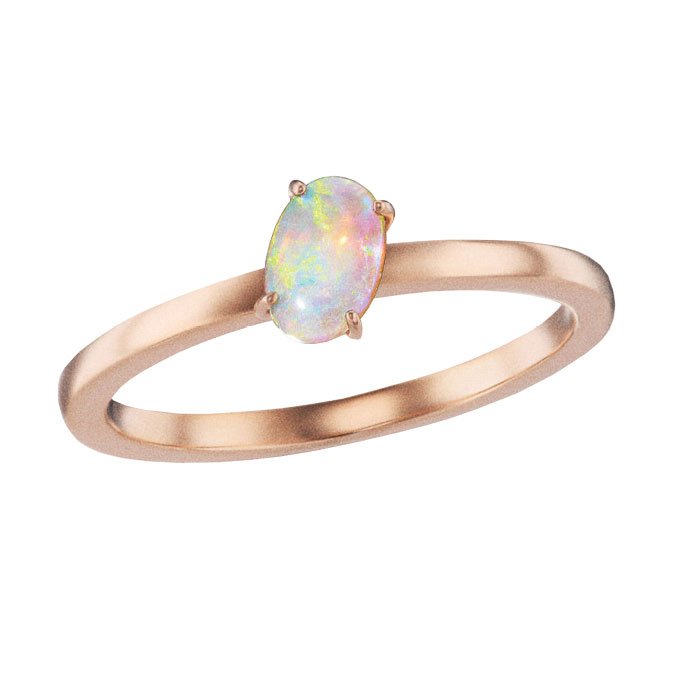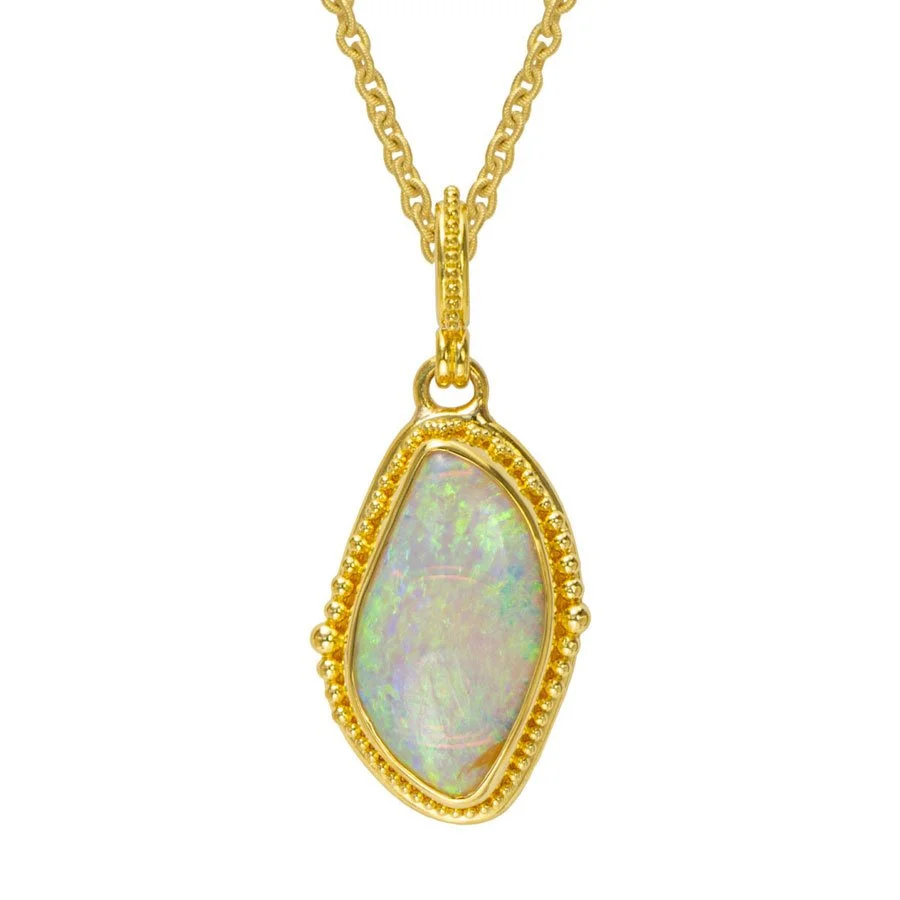OPAL JEWELRY WITH INTENTION AND CONNECTION
What is special about OPAL?
Play-of-color! This is a pattern of colors that are ideally wide, closely arranged, and flash in the light.
Natural opals that exhibit a black body tone with abundant play-of-color and exhibit “red display” are the most desirable.
Get the skinny on opal and shop a curation of intentional jewelry, thoughtfully designed by women…

SHOP
DESIGNER OPAL JEWELRY
Manifesting your intentions with opal
This gemstone attracts serenity, confidence, and freedom.
Just as our ancient ancestors believed gemstones were imbued with special properties, such as protection, wisdom, or courage, today we are empowered by the metaphysical properties of gemstones to manifest what we wish to create.
You may be interested in our guide to visualize your intentions through the metaphysical properties of gemstones and jewelry.
WHAT IS OPAL?
The earliest known opal artifacts are dated to 4,000 BC. While they were found in a cave in Kenya, they were likely mined in Ethiopia.
Multiple cultures believed opal was imbued with magical, protective and even “healing” powers. Arabic tales relay it came from the heavens in lightning flashes. The Aztecs believed it was a charm against the evil eye and curses. In ancient Greece, it guarded against disease. During the Middle Ages, it was the “eye stone” to promote good eye sight, as well as a talisman women would give to men when on Crusade, to bring him good luck and safe return.
We’ve outlined points to help you understand value and what to ask about opal jewelry.
Seeking personalized shopping support when investing in your jewelry collection?
Get expert guidance for jewelry with intention and connection!
What to know about opal - and discerning jewelry designed by WOMEN!
Are opals valuable?
Yes! Natural opals that exhibit a black body tone with abundant “play-of-color” are the most coveted.
The classification is uniquely complex. There are two broad classes: precious and common. Three types are solid (homogeneous in composition), boulder (solid, but naturally attached to host rock), and matrix (diffused in host rock).
What determines market value is the base color (black, dark, or light) and transparency (transparent, translucent, or opaque). They can occur in every color of the rainbow, with black being the most prized. Its ability to diffract light is distinctive, called “play-of-color”. Factors of this “play” include the body tone, the arrangement of color patterns (ideally large and tightly oriented) and the more vivid and wide-ranging the colors are, the better.
Like other gems, clarity and inclusions factor into market value. For clarity, this differs based on the kind. For black opal, an opaque background exhibits the best play-of-color, whereas, for crystal opal, transparency displays the best play-of-color. Material with milky or cloudy appearance is less appealing to experts. Along the lines of inclusions, blemishes or fragments of host rock can be present, as seen in matrix opals. Often this affects the value, but it can also be something that is uniquely beautiful to you!
SEEKING OPAL JEWELRY TO CELEBRATE YOUR STORY AND ELEVATE YOUR STYLE?
Beyond our discerning selection of curated opal jewelry, The Brilliant Concierge helps you invest in pieces that symbolize your personal journey or luxury jewelry gifts for your wife or someone you love.
Where is opal found?
While Australian opals are the most prized by collectors, they can be found around the world. Below is a list of countries and brief descriptions found in these locations.
AUSTRALIA: Australia produces the world’s largest supply of precious opals, including the most highly revered, rare black opal from Lightning Ridge.
ETHIOPIA: These hydrophane opals can be white, brown, yellow, orange or reddish in color with bright flashes of color. The best known are Welo opals from the Wollo Province. Always insist on disclosure, regarding if the gem is treated or untreated, as both exist in the market.
PERU: Known for their pink and blue common opal (versus precious), the stones are lovely even though they lack play-of-color.
MEXICO: The fire opal is the most well-regarded from Mexico. Their range is red, orange, yellow, or brown in body color and can be transparent to translucent. Also, they may or may not show play-of-color.
BRAZIL: These crystal opals vary from white, semi-transparent with unique pastel play-of-color to fully transparent body tone.
OTHER COUNTRIES: Canada, Czech Republic, Guatemala, Hungary, Honduras, Indonesia, and the United States.
The origin of gemstones: TRACEABILITY
Just as we know where our food comes from and who made our clothes, why not jewelry?
The breathtaking gems you see here are courtesy of Hopkins Opal, sourced from Australia.
Beyond ethical and conflict-free, responsible sourcing is a more holistic goal
Women and men at the forefront of this global conversation will have slightly different perspectives, but there is a shared ethos: responsible sourcing.
This encompasses traceability, conflict-free, protecting people, their skills, and the environment.
Opals can be treated to enhance their appearance and durability. Unlike other gemstones such as Sapphire, treating them is not a commonly accepted practice. Natural Australian (apart from Andamooka Matrix), Mexican and Brazilian material is very rarely treated. Ethiopian opals are the most treated from any location - and very unfortunately not always disclosed. All the more reason to buy from reputable sources and always ask if it is treated before purchase!
One treatment is a sugar treatment involving opals soaked in a sugar solution, followed by sulphuric acid. The process carbonizes the sugar, resulting in specks that blacken the body color and enhance the play-of-color.
Another treatment is smoking, which involves wrapping them in paper, followed by heating and smoking. Soot particles permeate the surface with the same result.
Other treatments involve plastic, resin, wax, colorless oil, and wax to minimize crazing.
When the gem material is thin, it can be “assembled” to make it stronger. A doublet is a thin slice backed with glass, obsidian, or other semi-precious material. A triplet is a thin slice sandwiched between domed colorless quartz and the same aforementioned backing.
Knowledge is power and any of the above treatments impact market value.
The MOHS SCALE:
How hard is OPAL?
on the soft side - wear with care
The Mohs scale of hardness is important to consider when choosing a particular stone for a particular kind of wear.
It is the degree of mineral “hardness”, measured by the resistance which a smooth surface offers to abrasion: 1 (soft) to 10 (hard). For example, an 8 will scratch a gemstone that is a 7 or below. Simply put, the softer the stone, the more careful you need to be about wearing that stone in jewelry that may be exposed to more wear.
Does opal scratch easily?
YES!
This is a question you’re most likely to ask when buying gemstones and jewelry. Knowing how hard it is (or any other stone) will help you to determine whether it is an everyday gemstone or an occasional piece.
While on the cusp of being in the hard range, it is brittle and porous at 5.5 - 6.5. This means it is more susceptible to damage with accidental bumps, choosing kinds of jewelry (i.e. necklaces or earrings) that will encounter less contact with harder surfaces is a good option, as are cocktail rings. It is not the most durable gemstone for an everyday ring unless it is thoughtfully designed to really protect it.
Because quartz is harder on the Mohs scale (at 7) and can be present in common dust, be sure to briefly wash it under warm water prior to wiping off any dust to prevent scratching
How to buy an opal…
…and wear and care considerations
How to care for opal jewelry
A few jewelry care basics can keep your pieces looking their best, avoid damage and loss of gemstones.
Be aware that opal is hydrated silica - containing up to 15% water. When it loses moisture, it can “craze” (a series of fine cracks). For this reason, do not leave these gems exposed to bright light, direct sunlight, or excessively dry or hot conditions.
WEAR: When dressing for day or night, jewelry should be the last thing on and the first thing off. Contact with chemicals such as fragrance, hairspray, nail polish remover, household cleaners, and chlorine can harm jewelry.
Especially with opals, remove jewelry when cleaning, gardening, swimming, or playing sports, as contact with hard surfaces can damage them or loosen stones in prongs.
CHECK SETTINGS AND STONES: Inspect jewelry before wearing it to check if the stones are chipped, loose, or rattle in settings.
CLEANING: All precious metals, gemstones, and pearls should be cleaned regularly, but require different care. For example, ultrasonic cleaners can crack opals, shatter pearls or diminish their appearance. Do not use steam or ultrasonic cleaners with opal.
● For gemstones on the Mohs scale at 7 or above, a simple cleaning solution is warm water with mild soap and a soft toothbrush. For those at 6 or below like opal, replace the toothbrush with a tightly woven microfiber or other soft cloth.
● A soft polishing cloth will keep any precious metal looking its best.
● Take any investment pieces to a trustworthy professional jeweler once a year for a thorough cleaning and inspection.
● See our full guide to How To Clean Fine Jewelry.
STORAGE: Keep opal jewelry individually stored in a pouch or box to avoid scratches and abrasions from other gemstones, as well as general tangles and dents. Chemicals, low humidity, and excessive hot/cold conditions can cause them to craze or crack - as mentioned above.
INSURANCE: For any jewelry of significant value, be sure to have it appraised, file any provenance and gemstone report in a secure place, and be sure to have it insured.
PERSONALIZED SHOPPING SUPPORT
All The Brilliants’ intentional jewelry concierge guides you in selecting:
cocktail rings
drop earrings and studs
pendants and layering necklaces
responsibly sourced opals for bespoke jewelry
Let’s connect for intentional jewelry that brings what’s inside out!























